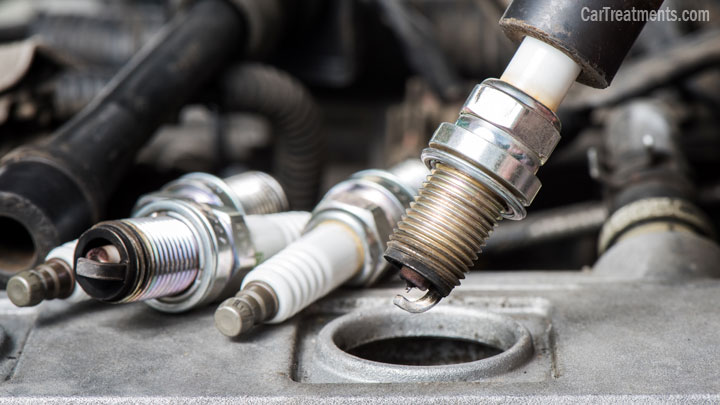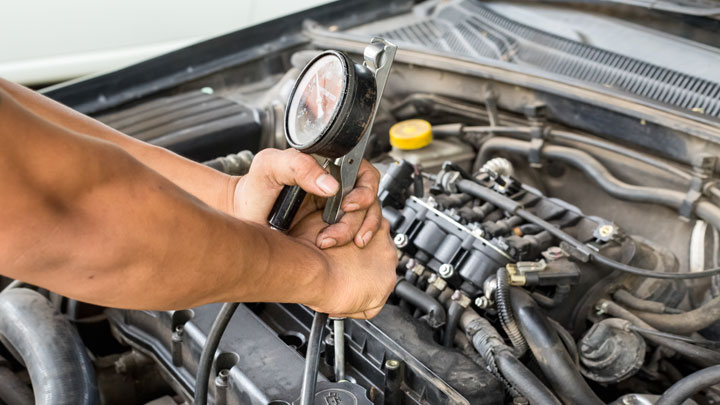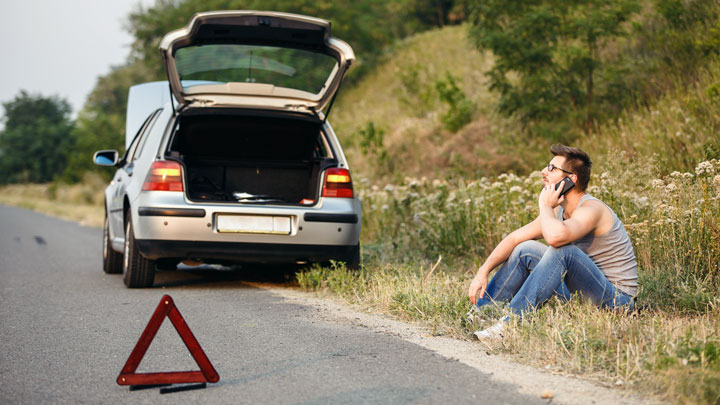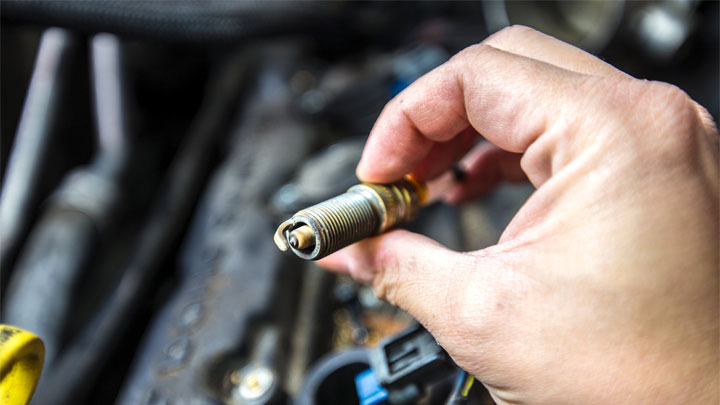Last Updated on November 17, 2021
Decades ago, my dad taught me a great deal about automobile problem diagnosis and repair. One thing he repeated time and time again:
“For an engine to run it must have three things: fuel, spark and compression. And these three must each happen at the right time”.
These three factors apply to conventional gasoline-fueled not diesel-fueled engines since diesels have no spark plugs. For diesels this discussion would consider only fuel and compression.
For your car or pickup truck to shut off while driving one or more of these three factors must have gone missing. Let’s examine them in the order presented above.
See Also: 5 Causes of Brakes Locking Up While Driving
Fuel Related

When fuel system problems crop up, two modes of failure are possible. The first is your car will run poorly. This may be a precursor to the second and more critical one, when your engine will quit and you will coast to a stop.
Common points of failure include a bad fuel pump, clogged fuel filter, or bad/clogged fuel injectors. Click through those links for specific symptoms to look for with each part.
Spark Related

The term ‘spark’ refers to the high voltage electrical spark generated by the ignition system at each of the spark plugs that ignites the fuel enabling the engine to run.
In a modern car the ignition system is driven by the Engine Control Module (ECM) or Powertrain Control Module (PCM). This module, a complex computer, signals the ignition system when to fire the spark plugs.
Related: ECU vs ECM vs PCM vs TCM (What’s the Difference?)
It does so by sending properly timed pulses of 12 volt electrical power to each of the spark coils. The coils then develop high voltage (25,000+ volts) which is sent to each spark plug generating the fuel igniting spark. Proper timing of this burst of power is determined by a signal from the engine crank position sensor.
Interruption of this precisely timed spark at each of the spark plugs can cause your engine to either run poorly or stop. Several different problems can cause this interruption.
#1 – ECM Problem
A failure of the ECM to provide a properly timed electrical signal will cause your engine to run poorly or stop.
#2 – Faulty Crank Position Sensor
This sensor can fail. When this happens no timing signal will be sent to the ECM. No signal = no spark. The engine, if running, will suddenly stop.
#3 – Wiring Problem
A broken or detached wire anywhere in this control circuit can prevent power to the coils and cause your engine to run poorly or stop.
#4 – Electrical Power Problem
The ECM will cease to operate if its 12 volt electrical power source fails. No power = no spark. Electrical wiring or battery and/or alternator failures can deprive the ECM of power and your car will shut down.
The Onboard Diagnostic System (OBD II) on your car can detect several ignition and ECM malfunctions and illuminate the Check Engine Light (CEL) warning you of an impending problem.
Taking concrete action when this light comes on is one way to ensure your car will not suddenly shut off and leave you stranded.
Compression Related

On any automobile engine in order to run, the pistons must be able to compress the incoming air-fuel mixture. This is an entirely mechanical process and is extremely reliable by design.
For this reason we’d be tempted to believe this could not fail. Unfortunately this is not so. There is one type of mechanical failure that can occur to this process which will cause the engine to quit.
Timing Chain or Belt Failure
The camshaft (or camshafts) are driven by the timing chain or belt. Failure of this component will cause the cams to stop rotating, and fuel-air compression will cease. The engine will stop. Severe internal engine damage may also accompany a timing belt or chain failure.
See Also: Bad Timing Belt Symptoms
Failure Probabilities and Ways to Minimize Risk
What types of failures are most probable? What are least probable? How could you help minimize risk for any of these failure modes? In order of probability, the most probable failure mode is listed first:
Fuel Problem
Fuel problems are fairly common. You actually have some control over reducing the risk of some of these failures. Take these steps:
- Keep track of fuel levels so you don’t run out of gas.
- Observe engine behaviors that may precede fuel system failures. See the “Fuel Pumps Can Fail” section for more information.
- Observe the periodic maintenance cycle for fuel filter replacement.
- Avoid buying gas at remote run down service stations. The storage tanks there may contain water and sludge contamination..
Spark Problem
Spark problems are less common than fuel problems. Here are several risk reducing actions you may follow:
- When driving, be aware of engine behavior. Misfiring (the car feels jerky) or backfiring can signal an impending ignition failure.
- Take corrective action when a Check Engine Light comes on. Such a light may be warning you of an impending engine shut down. See a qualified automobile technician as soon as possible if you don’t have access to an automotive scan tool.
- Perform scheduled ignition system maintenance especially the replacement interval for your spark plugs.
Compression Problem
Such problems are very rare. These possible precursors may give you an advance warning:
- Timing chain – A metallic rattling sound when starting the engine or during normal operation. This sound may come and go.
- Timing belt – A heavy intermittent or steady dragging sound audible with the hood open and the engine at idle speed or when revved up. Noise may come and go with changes in engine speed.
Either of these sounds, when first noticed should compel you to get the car to a qualified service technician as soon as possible. A timing belt or chain failure can result in considerable costly engine damage.
What Will Happen When Your Engine Stops?

Should your engine shut down, you may notice one or more of the following:
- The car will suddenly become quiet. Some of the interior noise is provided by the running engine. No engine, and sound levels suddenly drop. With an electrical failure that kills the engine, all interior noise sources like your sound system will also go silent.
- Steering may become heavy. This can occur when the engine stops running if your car has a power steering system with an engine-driven pump. When this pump stops, steering will become difficult. With an electrical failure, an electrically-driven power steering system may also display this behavior.
- Warning lights may come on. In your instrument panel a bunch of them may simultaneously illuminate. With an electrical failure, all panel lights will go dark, and the instruments may quit as well.
- Lights may extinguish. With an electrical failure, lighting will also fail including head, brake and tail lights. You could suddenly be plunged into darkness.
What Should You Do When Your Engine Stops?
When your engine dies, follow these steps:
- First, don’t panic. Your car will coast along but only so far. Get it to the side of the road as quickly as possible. If your lights have failed, try to avoid crossing busy traffic lanes.
- Get it stopped. Your power assisted brakes will be limited to two or three pedal presses. Once power assist is gone, the pedal force required to stop the car will greatly increase. For this reason, do not pump the pedal. Apply the brakes moderately or as needed and keep the pressure on until the car stops.
- Emergency flashers. If the lights still work, turn on the emergency flashers.
- Restart the engine? You may attempt to restart the engine. If it starts and you choose to continue driving, bear in mind it may quit again at any moment.
- Call for help? If it won’t restart, get help. Call 911 especially if you are blocking a traffic lane or your car stops partially on the pavement. And since your engine will not run, you will need to call for a tow.
- Blocking a traffic lane? If you are stuck in a lane or still partially on the road, check traffic behind and exit the car if this can be done safely. This is especially critical at night. Get yourself and passengers well off the pavement.
- Deploy reflective triangles or road flares. Think the situation couldn’t get worse? Think again. Many disabled vehicles on the road have been struck by other drivers. Make sure they see by utilizing a road flare or reflective triangle that should be in the emergency kit in your trunk. You do have an emergency kit, right?
- If engine stop was accompanied by a loud clattering noise, do not attempt to restart it. Doing so could cause additional engine damage.





This is good, I have learned from the site and it’s helpful to me.